The Atomic Bombings of Hiroshima and Nagasaki killed about 250.000 people and became the most dreadful slaughter of civilians in modern history. However, for many years there was a curious gap in the photographic records. Although the names of Hiroshima and Nagasaki were incised into our memories, there were few pictures to accompany them. Even today, the image in our minds is a mixture of devastated landscapes and shattered buildings. Shocking images of the ruins, but where were the victims?
 The American occupation forces imposed strict censorship on Japan, prohibiting anything "that might, directly or by inference, disturb public tranquility" and used it to prohibit all pictures of the bombed cities. The pictures remained classified 'top secret' for many years. Some of the images have been published later by different means, but it's not usual to see them all together. This is the horror they didn't want us to see, and that we must NEVER forget:
The American occupation forces imposed strict censorship on Japan, prohibiting anything "that might, directly or by inference, disturb public tranquility" and used it to prohibit all pictures of the bombed cities. The pictures remained classified 'top secret' for many years. Some of the images have been published later by different means, but it's not usual to see them all together. This is the horror they didn't want us to see, and that we must NEVER forget:
1. Signals
 All the watches found in the ground zero were stopped at 8:15 am, the time of the explosion.
All the watches found in the ground zero were stopped at 8:15 am, the time of the explosion.
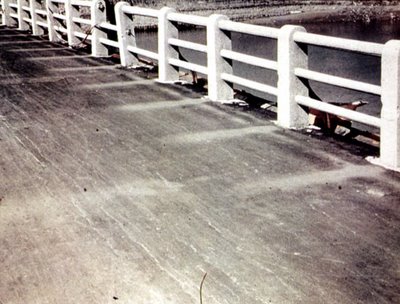 Within a certain distance from the site of explosion, the heat was so intense that practically everything was vaporised. The shadows of the parapets were imprinted on the road surface of the Yorozuyo Bridge, 1/2 of a mile south-southwest of the hypocenter. Besides, in Hiroshima, all that was left of some humans, sitting on stone benches near the centre of explosion, was their outlines.
Within a certain distance from the site of explosion, the heat was so intense that practically everything was vaporised. The shadows of the parapets were imprinted on the road surface of the Yorozuyo Bridge, 1/2 of a mile south-southwest of the hypocenter. Besides, in Hiroshima, all that was left of some humans, sitting on stone benches near the centre of explosion, was their outlines.
 The photograph bellow shows the stone steps of a Bank where a person was incinerated by the heat rays.
The photograph bellow shows the stone steps of a Bank where a person was incinerated by the heat rays.

2. The massacre
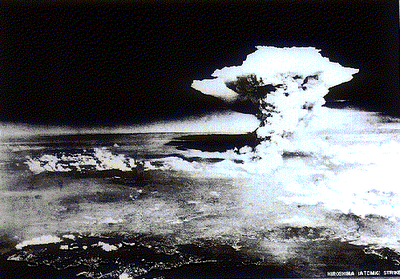 On August 6, 1945, 8.15 am, the uranium atom bomb exploded 580 metres above the city of Hiroshima with a blinding flash, creating a giant fireball and sending surface temperatures to 4,000C. Fierce heat rays and radiation burst out in every direction, unleashing a high pressure shockwave, vaporising tens of thousands of people and animals, melting buildings and streetcars, reducing a 400-year-old city to dust.
On August 6, 1945, 8.15 am, the uranium atom bomb exploded 580 metres above the city of Hiroshima with a blinding flash, creating a giant fireball and sending surface temperatures to 4,000C. Fierce heat rays and radiation burst out in every direction, unleashing a high pressure shockwave, vaporising tens of thousands of people and animals, melting buildings and streetcars, reducing a 400-year-old city to dust.
 Housewives and children were incinerated instantly or paralysed in their daily routines, their internal organs boiled and their bones charred into brittle charcoal.
Housewives and children were incinerated instantly or paralysed in their daily routines, their internal organs boiled and their bones charred into brittle charcoal.
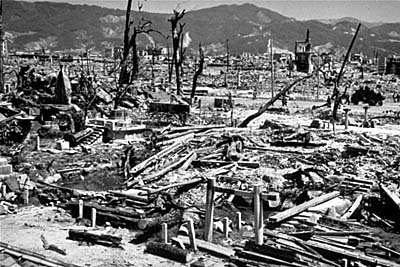 Beneath the center of the explosion, temperatures were hot enough to melt concrete and steel. Within seconds, 75,000 people had been killed or fatally injured with 65% of the casualties nine years of age and younger.
Beneath the center of the explosion, temperatures were hot enough to melt concrete and steel. Within seconds, 75,000 people had been killed or fatally injured with 65% of the casualties nine years of age and younger.
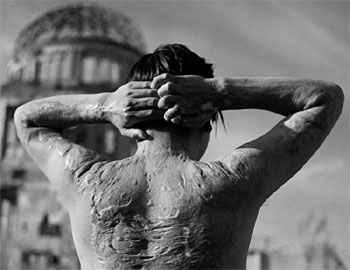
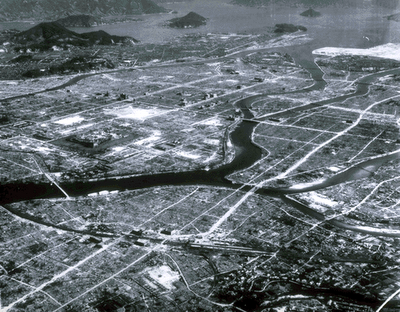 Radiation deaths were still occurring in large numbers in the following days. "For no apparent reason their health began to fail. They lost appetite. Their hair fell out. Bluish spots appeared on their bodies. And then bleeding began from the ears, nose and mouth".
Radiation deaths were still occurring in large numbers in the following days. "For no apparent reason their health began to fail. They lost appetite. Their hair fell out. Bluish spots appeared on their bodies. And then bleeding began from the ears, nose and mouth".
 Doctors "gave their patients Vitamin A injections. The results were horrible. The flesh started rotting from the hole caused by the injection of the needle. And in every case the victim died".
Doctors "gave their patients Vitamin A injections. The results were horrible. The flesh started rotting from the hole caused by the injection of the needle. And in every case the victim died".
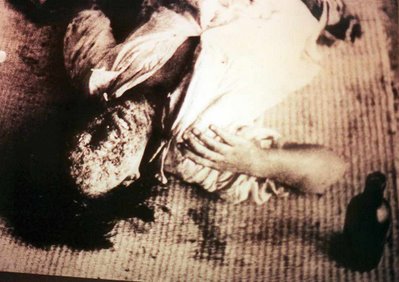

 This photograph shows an eyeball of an A-bomb victim who got an atomic bomb cataract. There is opacity near the center of the eyeball.
This photograph shows an eyeball of an A-bomb victim who got an atomic bomb cataract. There is opacity near the center of the eyeball.


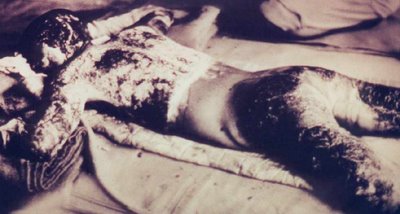

3. Hibakusha
 Hibakusha is the term widely used in Japan referring to victims of the atomic bombings of Hiroshima and Nagasaki. The Japanese word translates literally to "explosion-affected people".
Hibakusha is the term widely used in Japan referring to victims of the atomic bombings of Hiroshima and Nagasaki. The Japanese word translates literally to "explosion-affected people".
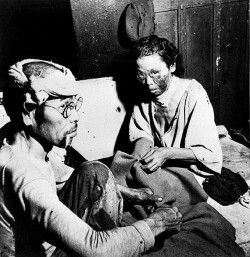 They and their children were (and still are) victims of severe discrimination due to lack of knowledge about the consequences of radiation sickness, which people believed to be hereditary or even contagious.
They and their children were (and still are) victims of severe discrimination due to lack of knowledge about the consequences of radiation sickness, which people believed to be hereditary or even contagious.
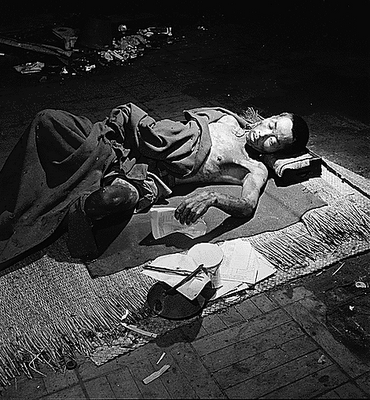 Many of them were fired from their jobs. Hibakusha women never got married, as many feared they would give birth to deformed children. Men suffered discrimination too. "Nobody wanted to marry someone who might die in a couple of years".
Many of them were fired from their jobs. Hibakusha women never got married, as many feared they would give birth to deformed children. Men suffered discrimination too. "Nobody wanted to marry someone who might die in a couple of years".

4. Yamahata, the photographer of Nagasaki
 On Agust 10, 1945, the day after the bombing of Nagasaki Yosuke Yamahata, began to photograh the devastation. The city was dead. He walked through the darkened ruins and the dead corpses for hours. By late afternoon, he had taken his final photographs near a first aid station north of the city. In a single day, he had completed the only extensive photographic record of the immediate aftermath of the atomic bombing of either Hiroshima or Nagasaki.
On Agust 10, 1945, the day after the bombing of Nagasaki Yosuke Yamahata, began to photograh the devastation. The city was dead. He walked through the darkened ruins and the dead corpses for hours. By late afternoon, he had taken his final photographs near a first aid station north of the city. In a single day, he had completed the only extensive photographic record of the immediate aftermath of the atomic bombing of either Hiroshima or Nagasaki.
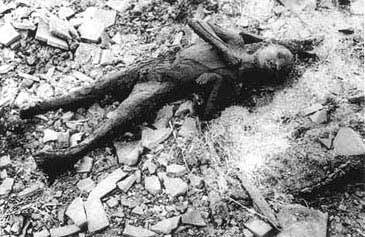 “A warm wind began to blow - he wrote later - Here and there in the distance I saw many small fires, like elf-fires, smoldering. Nagasaki had been completly destroyed"
“A warm wind began to blow - he wrote later - Here and there in the distance I saw many small fires, like elf-fires, smoldering. Nagasaki had been completly destroyed"
 Mr. Yamahata's photographs are the most complete record of the atomic bombing as seen in the most immediate hours after the bombing. The New York Times has called Mr. Yamahata's photographs, "some of the most powerful images ever made".
Mr. Yamahata's photographs are the most complete record of the atomic bombing as seen in the most immediate hours after the bombing. The New York Times has called Mr. Yamahata's photographs, "some of the most powerful images ever made".

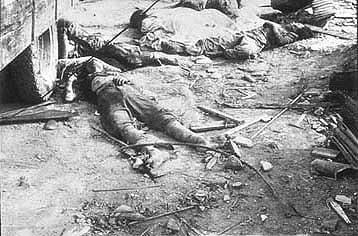
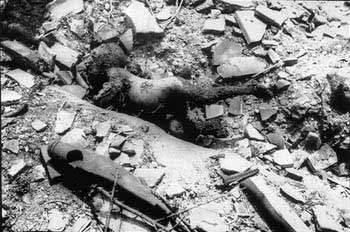

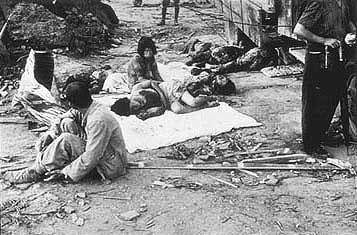
 Mr. Yamahata became violently ill on August 6, 1965, his forty-eighth birthday and the twentieth anniversary of the bombing of Hiroshima. He was diagnosed with terminal cancer of the duodenum, probably caused by the residual effects of radiation received in Nagasaki in 1945. He died on April 18, 1966, and is buried at Tama Cemetery, Tokyo.
Mr. Yamahata became violently ill on August 6, 1965, his forty-eighth birthday and the twentieth anniversary of the bombing of Hiroshima. He was diagnosed with terminal cancer of the duodenum, probably caused by the residual effects of radiation received in Nagasaki in 1945. He died on April 18, 1966, and is buried at Tama Cemetery, Tokyo.
 The American occupation forces imposed strict censorship on Japan, prohibiting anything "that might, directly or by inference, disturb public tranquility" and used it to prohibit all pictures of the bombed cities. The pictures remained classified 'top secret' for many years. Some of the images have been published later by different means, but it's not usual to see them all together. This is the horror they didn't want us to see, and that we must NEVER forget:
The American occupation forces imposed strict censorship on Japan, prohibiting anything "that might, directly or by inference, disturb public tranquility" and used it to prohibit all pictures of the bombed cities. The pictures remained classified 'top secret' for many years. Some of the images have been published later by different means, but it's not usual to see them all together. This is the horror they didn't want us to see, and that we must NEVER forget:1. Signals
 All the watches found in the ground zero were stopped at 8:15 am, the time of the explosion.
All the watches found in the ground zero were stopped at 8:15 am, the time of the explosion. Within a certain distance from the site of explosion, the heat was so intense that practically everything was vaporised. The shadows of the parapets were imprinted on the road surface of the Yorozuyo Bridge, 1/2 of a mile south-southwest of the hypocenter. Besides, in Hiroshima, all that was left of some humans, sitting on stone benches near the centre of explosion, was their outlines.
Within a certain distance from the site of explosion, the heat was so intense that practically everything was vaporised. The shadows of the parapets were imprinted on the road surface of the Yorozuyo Bridge, 1/2 of a mile south-southwest of the hypocenter. Besides, in Hiroshima, all that was left of some humans, sitting on stone benches near the centre of explosion, was their outlines. The photograph bellow shows the stone steps of a Bank where a person was incinerated by the heat rays.
The photograph bellow shows the stone steps of a Bank where a person was incinerated by the heat rays.
2. The massacre
 On August 6, 1945, 8.15 am, the uranium atom bomb exploded 580 metres above the city of Hiroshima with a blinding flash, creating a giant fireball and sending surface temperatures to 4,000C. Fierce heat rays and radiation burst out in every direction, unleashing a high pressure shockwave, vaporising tens of thousands of people and animals, melting buildings and streetcars, reducing a 400-year-old city to dust.
On August 6, 1945, 8.15 am, the uranium atom bomb exploded 580 metres above the city of Hiroshima with a blinding flash, creating a giant fireball and sending surface temperatures to 4,000C. Fierce heat rays and radiation burst out in every direction, unleashing a high pressure shockwave, vaporising tens of thousands of people and animals, melting buildings and streetcars, reducing a 400-year-old city to dust. Housewives and children were incinerated instantly or paralysed in their daily routines, their internal organs boiled and their bones charred into brittle charcoal.
Housewives and children were incinerated instantly or paralysed in their daily routines, their internal organs boiled and their bones charred into brittle charcoal. Beneath the center of the explosion, temperatures were hot enough to melt concrete and steel. Within seconds, 75,000 people had been killed or fatally injured with 65% of the casualties nine years of age and younger.
Beneath the center of the explosion, temperatures were hot enough to melt concrete and steel. Within seconds, 75,000 people had been killed or fatally injured with 65% of the casualties nine years of age and younger.
 Radiation deaths were still occurring in large numbers in the following days. "For no apparent reason their health began to fail. They lost appetite. Their hair fell out. Bluish spots appeared on their bodies. And then bleeding began from the ears, nose and mouth".
Radiation deaths were still occurring in large numbers in the following days. "For no apparent reason their health began to fail. They lost appetite. Their hair fell out. Bluish spots appeared on their bodies. And then bleeding began from the ears, nose and mouth". Doctors "gave their patients Vitamin A injections. The results were horrible. The flesh started rotting from the hole caused by the injection of the needle. And in every case the victim died".
Doctors "gave their patients Vitamin A injections. The results were horrible. The flesh started rotting from the hole caused by the injection of the needle. And in every case the victim died".

 This photograph shows an eyeball of an A-bomb victim who got an atomic bomb cataract. There is opacity near the center of the eyeball.
This photograph shows an eyeball of an A-bomb victim who got an atomic bomb cataract. There is opacity near the center of the eyeball.



3. Hibakusha
 Hibakusha is the term widely used in Japan referring to victims of the atomic bombings of Hiroshima and Nagasaki. The Japanese word translates literally to "explosion-affected people".
Hibakusha is the term widely used in Japan referring to victims of the atomic bombings of Hiroshima and Nagasaki. The Japanese word translates literally to "explosion-affected people". They and their children were (and still are) victims of severe discrimination due to lack of knowledge about the consequences of radiation sickness, which people believed to be hereditary or even contagious.
They and their children were (and still are) victims of severe discrimination due to lack of knowledge about the consequences of radiation sickness, which people believed to be hereditary or even contagious. Many of them were fired from their jobs. Hibakusha women never got married, as many feared they would give birth to deformed children. Men suffered discrimination too. "Nobody wanted to marry someone who might die in a couple of years".
Many of them were fired from their jobs. Hibakusha women never got married, as many feared they would give birth to deformed children. Men suffered discrimination too. "Nobody wanted to marry someone who might die in a couple of years".
4. Yamahata, the photographer of Nagasaki
 On Agust 10, 1945, the day after the bombing of Nagasaki Yosuke Yamahata, began to photograh the devastation. The city was dead. He walked through the darkened ruins and the dead corpses for hours. By late afternoon, he had taken his final photographs near a first aid station north of the city. In a single day, he had completed the only extensive photographic record of the immediate aftermath of the atomic bombing of either Hiroshima or Nagasaki.
On Agust 10, 1945, the day after the bombing of Nagasaki Yosuke Yamahata, began to photograh the devastation. The city was dead. He walked through the darkened ruins and the dead corpses for hours. By late afternoon, he had taken his final photographs near a first aid station north of the city. In a single day, he had completed the only extensive photographic record of the immediate aftermath of the atomic bombing of either Hiroshima or Nagasaki. “A warm wind began to blow - he wrote later - Here and there in the distance I saw many small fires, like elf-fires, smoldering. Nagasaki had been completly destroyed"
“A warm wind began to blow - he wrote later - Here and there in the distance I saw many small fires, like elf-fires, smoldering. Nagasaki had been completly destroyed" Mr. Yamahata's photographs are the most complete record of the atomic bombing as seen in the most immediate hours after the bombing. The New York Times has called Mr. Yamahata's photographs, "some of the most powerful images ever made".
Mr. Yamahata's photographs are the most complete record of the atomic bombing as seen in the most immediate hours after the bombing. The New York Times has called Mr. Yamahata's photographs, "some of the most powerful images ever made".




 Mr. Yamahata became violently ill on August 6, 1965, his forty-eighth birthday and the twentieth anniversary of the bombing of Hiroshima. He was diagnosed with terminal cancer of the duodenum, probably caused by the residual effects of radiation received in Nagasaki in 1945. He died on April 18, 1966, and is buried at Tama Cemetery, Tokyo.
Mr. Yamahata became violently ill on August 6, 1965, his forty-eighth birthday and the twentieth anniversary of the bombing of Hiroshima. He was diagnosed with terminal cancer of the duodenum, probably caused by the residual effects of radiation received in Nagasaki in 1945. He died on April 18, 1966, and is buried at Tama Cemetery, Tokyo.